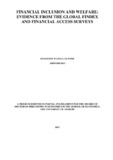| dc.description.abstract | This thesis focuses on financial inclusion and its potential to ensuring that the key segments of the population derive benefits arising from accessing and using a wide array of financial services. A cross-country analysis is carried out to investigate the extent to which determinants and constraints to financial inclusion vary across different countries within the sub-Saharan Africa region. The thesis further isolates savings mobilization and credit access as key aspects of financial inclusion and performs a seemingly unrelated regression analysis to derive the most critical factors that jointly drive policy in Kenya and Tanzania. The conceptual and theoretical frameworks underpinning the empirical modelling are presented. Finally, the thesis examines the potential effect of financial innovation on household welfare. To bring out these differences, the thesis utilized the user-side data taking into account hierarchies within data and potential heterogeneity in the sub-populations. The datasets utilized were obtained from the Global Findex wave of 2014 survey, FinAccess and FinScope waves of 2013 surveys. The use of a multilevel approach was motivated by the stratification of the data into clearly delineated sub-populations constituting levels: individual household level and country level. Estimation results showed that country differences explain more than 10 percent of the observed aspects of account ownership. The results further showed that at lower levels of income there is less association between earnings and account ownership. However, compared to owning an account with a mobile phone service provider, the results showed greater association between account ownership and earnings. The majority of those who transact through the mobile account platform are less endowed with resources. Similarly, the study established that age was negatively associated with ownership of account. Older households were less likely to own an account implying that aging is negatively associated with households desire to hold an account. Countries exhibited marked differences in financial inclusion. The differences were explained by individual household differences as well as country differences. The main financial inclusion barriers identified included households‟ lack of money income, the cost of financial
services and the distance to the nearest point of service. These barriers were found to be associated with lower income levels and lower education attainment. The thesis concludes that compared to other forms of account ownership, the mobile phone account appeared to serve the lower end individuals who largely exhibit lower levels of education and are likely to be found at the lower end of the income spectrum. Aging was found to have the effect of switching households from one financial service to another. The findings suggest that both demographic and socioeconomic factors are critical determinants of access to savings and credit services in Kenya and Tanzania. More emphasis has been laid on the importance of socioeconomic factors such as age, gender, education, marital status, social capital, and income. The implication of having more people access formal savings and credit is to prevent unnecessary risks associated with informal and/or exclusion. Economic theory lends credence to these findings by affirming the role of savings in the investment model. The findings further revealed the role played by agency banking services on household welfare. Agency banking was found to have a positive significant effect on the welfare if it targeted individuals within the upper class in the wealth quintile. On the other hand, the mobile banking services would be more relevant if it focused on the middle class in the wealth quintile. Therefore, promotion of branchless banking is an important innovation that holds great potential to transforming the welfare of households. | en_US |



